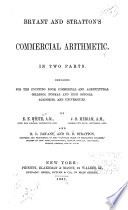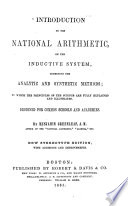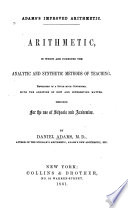 | Horatio Nelson Robinson - Arithmetic - 1860 - 444 pages
...credit of C months on $15, because 45 X 00 = 270 X 1. Hence the following RULE. I. Multiply each payment by its term of credit, and divide the sum of the products by the sum of the payments; the quotient will be the average term of credit. II. Add the average term of credit to the date at... | |
 | Benjamin Greenleaf - Arithmetic - 1860 - 456 pages
...payment to be 43 days, nearly, from May 1, or on June 13. RULE. — Multiply each payment by its own time of credit, and divide the sum of the products by the sum of the payments. NOTE 1. — When the date of the average time of payment is required, as in Example 2, Jind the time... | |
 | Benjamin Greenleaf - Arithmetic - 1860 - 324 pages
...for the payment of the whole. Hence the following RULE. -—Multiply each payment by its own time, of credit, and divide the sum of the products by the sum of the payments. NOTE 1. — This is the rule usually adopted by merchants, but it is not perfectly correct ; for" if... | |
 | Emerson Elbridge White - Arithmetic (Commercial), 1861 - 1861 - 348 pages
...hundredths of 9600 months=8 months, the equated time. RULE. — Multiply each payment or debt by its time of credit, and divide the sum of the PRODUCTS by the sum of the PAYMENTS. Note. — 1. By the term discount, as used above, is meant mercantile discount or simple interest.... | |
 | Education - 1861 - 712 pages
...at the starting point. The rule for Equation of Payments is, " multiply each payment by its own time of credit, and divide the sum of the products by the sum of the payments," — another case in point. I have put down some of the more prominent faults in the books, frankly... | |
 | Benjamin Greenleaf - Arithmetic - 1861 - 338 pages
...time for the payment of the whole. Hence the following RULE. — Multiply each payment by its own time of credit. and divide the sum of the products by the sum of the payments. NOTE 1. — This is the rule usually adopted by merchants, but it is not perfectly correct ; for if... | |
 | Charles Davies - Arithmetic - 1861 - 496 pages
...find the average time of payment : Rule. — Multiply each payment by the time before it becomes due, and divide the sum of the products by the sum of the payments: the Quotient will be the average time. Examples. 1. A merchant ows $1200, of which $200 is to be paid... | |
 | Daniel Adams - Arithmetic - 1861 - 452 pages
...Hence, To find the mean time of several, payments, — RULE. Multiply each sum by its tune of payment, and divide the sum of the products by the sum of the payments ; the quotient will be the equated tune. EXAMPLES. 2. A Western merchant owes in New York city $200,... | |
 | Edward Brooks - Arithmetic - 1863 - 350 pages
...credit of jJ-3 of 1500 months, which is 3J months. Hence RULE. — Multiply each payment ly its time, and divide the sum of the products by the sum of the payments, the quotient will lie, the average term of credit. 2. A owes B §6000, J due in 3mo., | in 4mo., and... | |
 | Charles Davies - Arithmetic - 1863 - 346 pages
...$12 " " J_X 12 = 12. $6 $48 6 6)48. Rule. Multiply each payment by the time before it becomes due, and divide the sum of the products by the sum of the payments: the quotient will be the mean time. Examples. 2. A owes B $600 ; one-third is to be paid in 6 months... | |
| |